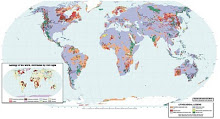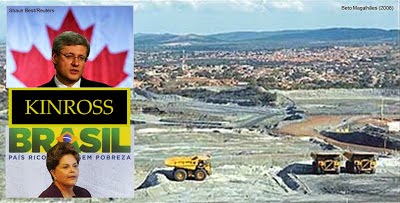Nothing in the drinking-water-for-poison swap in Paracatu makes sense except down the corruption pipeline
By Sergio U. Dani, from Göttingen, April 4, 2010
The Santa Isabel river is drying up. It has lost 3 billion liters of water in the last 18 years. Since 1996 this river has been the main source of drinking water for the 84 thousand inhabitants of Paracatu, a city located in the northwestern part of the Minas Gerais State, Brazil.
Until 1996, water supply to this 300 year old city relied upon the Rico Creek and water springs and wells located within the city and in the neighbour Santa Rita river basin. Beginning in 1987, an open pit gold mine has destroyed the waterheads of Rico Creek, and has contributed to the depletion or contamination the city’s wells.
Now the Santa Rita waterheads, which are considered the earliest and most valuable source of drinking water out of the urban environment of Paracatu – the water used to be delivered to the city by gravity through the famous “Master of Field Trench” – are at risk of being transformed into a deposit of over one billion tons of toxic mine tailings.
The tailings will contain one million tons of arsenic which is enough poison to kill billions of people. Besides directly destroying the sources of drinking water, mining activities are contaminating groundwater with poison and acid drainage.
The waterheads of the Santa Rita and Santa Isabel rivers make up a connected hydrogeological system known as "Serra da Anta System". Damage to any of the constituents of this system will severely impact water supply to Paracatu.
The huge social and environmental damage caused by gold mining operations in Paracatu exceeds the gross value of gold reserves, according to estimates based on studies by the EPA-Environmental Protection Agency of the U.S. and by Kinross Gold Corporation itself put together in a lawsuit by the Acangau Foundation.
In 2009, mining activities contributed only 4% of the total tax income and 6% of the jobs in Paracatu. In an Internet poll run in 2009, 93% of over 1000 people voted against the expansion project of the mining which is bound to destroy valuable sources of drinking water.
Only corruption accounts for the governmental issuing of permits to the expansion of the gold mine in August 2009. Kinross Gold Corporation admits the practice of "facilitating payments" in its code of ethics in business.
Public managers are jointly responsible for damage, as is the case of the Municipality which has already been brought officially to run an epidemiological survey of chronic poisoning by arsenic in Paracatu and nothing published about the results. The State administrator aggravates his guilt when he tries to justify his failure by claiming instrumental helplessness or ignorance.
In March 2010, Paracatu was included in the official map of conflicts involving environmental injustice and health in Brazil. This map has been prepared by the Oswaldo Cruz Foundation-Fiocruz and by the Socio-educational Foundation-FASE, with the support of the Brazilian Ministry of Health.
Paracatu has been included in this map in recognition of the serious consequences of the open pit gold mining activities within the city which include: severe and persistent environmental pollution, chronic exposure to arsenic and other toxic substances, destruction of drinking water sources and expelling of traditional communities, among other injustices.
Contamination of soil, air and water pollution and corruption caused by Kinross Gold Corporation in Paracatu threaten the sustainability of the city's economic development and directly affect society.
Sunday, April 4, 2010
Subscribe to:
Post Comments (Atom)




No comments:
Post a Comment